I recently received a new, old Lectionarium from Fraternity Publications, the publishing arm of the FFSP, Fraternity of St. Peter. This liturgical book is used during Solemn Mass in the traditional Roman Rite. It contains the texts of the Epistles and the Gospels to be sung by the subdeacon and deacon.
It is bound in red leather cover and is approximately 10″ x 14″ x 1 7/8″. It has , two high ribbon markers. The edges of the pages are gilded.
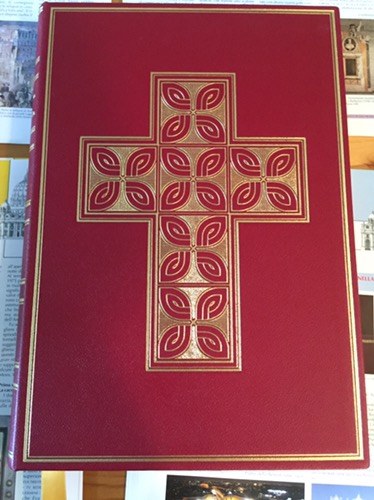
The spine.
There is a nice colored plate at the beginning.
It’s bona fides.
The type face is a little more ornate than I would prefer but it is easily legible.
The ribbons have a couple nice touches. First, the are reinforced at the connection to the spine. Also, they are finished at the end. They are designed, with care, to last.
The notation for the Exsultet is included, which is fitting, since it is something to be sung by a deacon.
By way of comparison, this is a shot of my other, older Lectionarium. Again, this is an older book…
Now back to the new volume. A shot with items… just for scale.
The book is not inexpensive, but it is a one time purchase.
If your TLM community needs one, consider getting it and donating it. However, check with the priest before you get it. Make sure that a) they don’t have one and b) that there isn’t something more urgent to acquire.
Our liturgical books should be elegant, as well as useful.
One thing might improve the volume, even though it was not included in older editions. It would perhaps be helpful to include templates with Gregorian notation for the chants of the readings.
There are modes that have become standard in the Roman Rite and every seminarian and cleric should know them. Alas, I have not heard of any seminary out there where they are taught. I would love to be corrected. I hope seminarians will drop me a line. I’ll protect your identity, of course.
There is a huge lacuna in liturgical training in all things Latin in this our ailing Latin Rite Church. And yet the Code of Canon Law clearly states that seminarians should be very well-trained in Latin (can. 249). Their training of Latin matters liturgy should be thorough.
The Fathers of the Second Vatican Council mandated that pastors of souls should make sure that their flocks should be able to both sing and speak the parts that pertain to them in both Latin and their mother tongue. But if that is a requirement of the Conciliar reform for lay people in the pews, how much more important is it that their clergy know how to sing the parts that pertain to them in Latin, which is the language of their Rite?
The templates for singing the orations and readings for Mass are found, for example, in the Liber Usualis. I think they ought to be included in the Lectionarium, even if they were not included in the past. We need them today. And we need people to teach the seminarians and clergy what those tones are. Many of them can’t read music. And there are also some who don’t hear the difference between whole and half steps. They should be helped to hear and sing the correct intervals. That means practice.
Practice.
This brings to mind a book from the Canons at St. John Cantius which has all the variations of tones of orations and of the readings in chant notation. I wrote about it HERE. The Cantius book, Canticum Clericorum Romanum, is a helpful book, to be sure. It is great for practice. It is far better that seminarians and clergy know their chants without using this… “cheat sheet”. They should more properly use the elegant, liturgical book, such as this Lectionarium from Fraternity Publications.

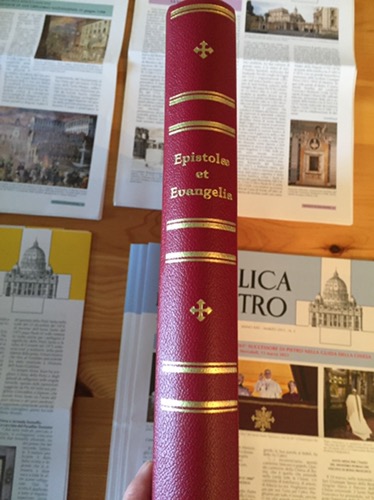

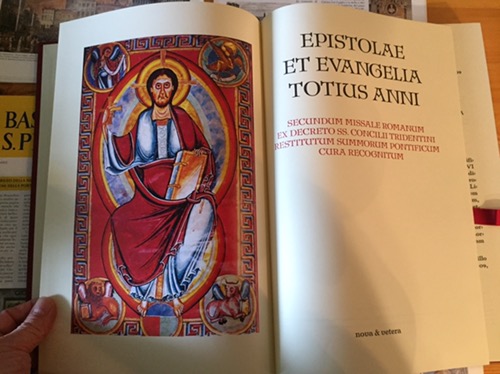
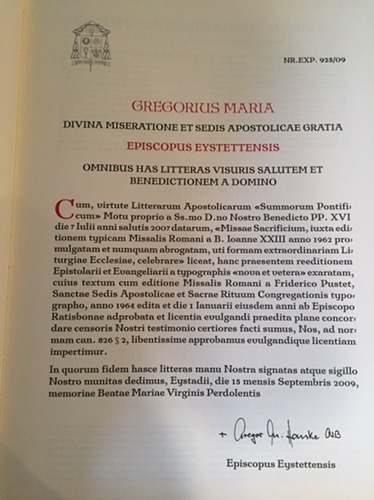
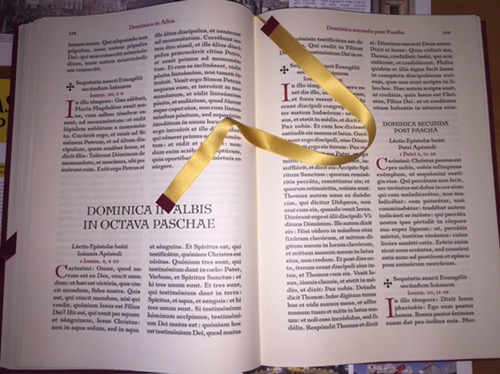
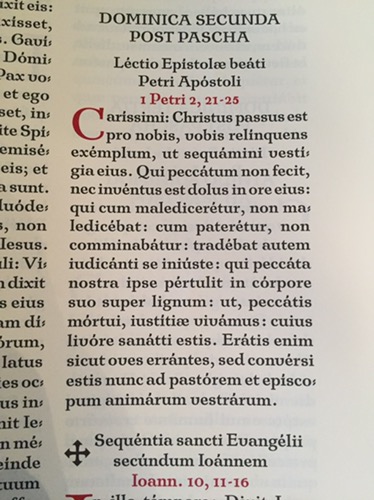

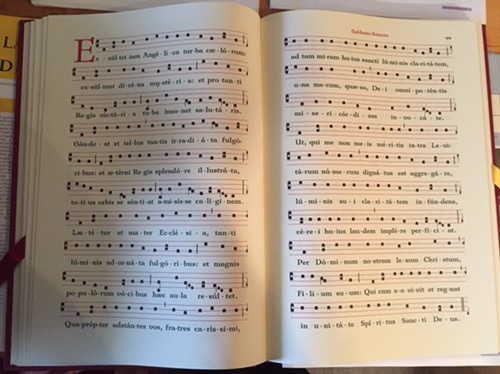
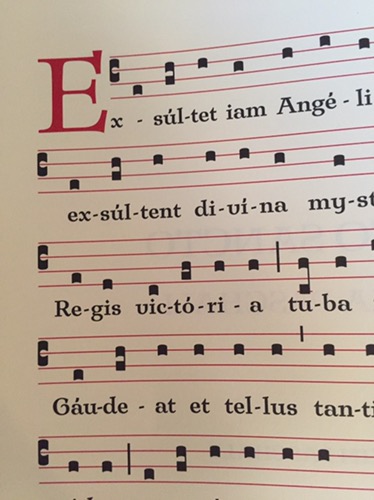
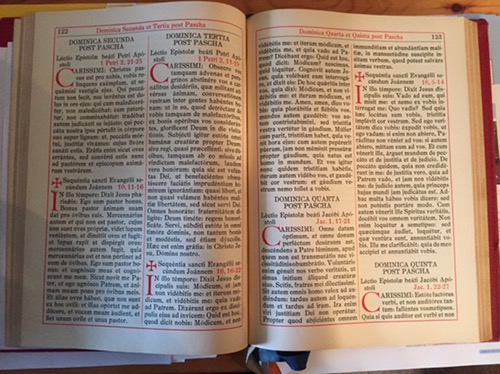



































The EV is also available directly from its original publisher : Nova & Vetera in Germany (liturgica.net).
Their price is 350 €, which is a significant discount (about $80) from what Fraternity Publications is reselling for, and shipping is about the same cost. [Of course we want to help the FSSP. Right? That’s part of the point of this.]
From my experience ordering a breviary directly from n&v, it was only about a week for the shipping to get to the U.S. from Germany.
“There are modes that have become standard in the Roman Rite and every seminarian and cleric should know them. Alas, I have not heard of any seminary out there where they are taught.”
Surely, the FSSP Our Lady of Guadalupe Seminary?
[Well, yes. Forgive me for not including the obvious in my rant.]
You are absolutely right Father. I bought this lectionarium several years ago for our parish TLM and every time we end up taping print outs with notation inside the book.
Some words, if we do not use the letter “j” cannot be visually differentiated. For example “Jactans” and “lactans” without a “j” will look exactly the same in both cases as “Iactans”. [Other than the fact that one will have an i and the other an l?]
When an edition avoids using the letter “j” the reader has to make on the spot decisions while reading: “am I looking at a capital “I” as in “Job” or is this a small letter “l” as in “lob”? [In general, the priest, deacon and subdeacon have a look at the texts before they say Mass. It’s not always “on the spot”.]
Wisely, the older edition shown above, uses the letter “J” and thus it is much more legible. [Js are debatable. I do well without them.]
The new Liturgia Horarum and new editions of the Vulgata and now this: everyone is dropping the letter “J” so that “Jesus” can become “Iesus”. Why? [Because (pace the famous story!) there is no j in Latin.]
They seem to adhere to the conviction that it is more “learned” somehow, that it is more Latin to avoid the letter “j” because the Romans didn’t use it. There are many things the Romans didn’t use that we would not wish to give up: a printing press is one of them. We don’t somehow contaminate or diminish the Latin language by writing “Jesus” and “Joannes” instead of “Iesus” and “Ioannes”. The irony of it is that this is happening at a time when fewer and fewer individuals are able to read (never mind understand) this language. As if our biggest problem was to be found in avoiding modern writing methods. Some editions go as far as using the same letter for “u” and “v” so that words such as “uva” are printed as “uua”. [I haven’t seen such an edition yet.]
If I may just make an observation, it does not seem to have dotted punctums or icti to denote rhythm. And then, for something like the “Exultet,” it seems that something like a mode number would be useful in determining your finals and dominants.
[At this point, knowing Latin, it’s obvious.]
Your older book is much, MUCH more legible.
The seventh picture shows a typo ‘cuius livore sanatti estis’ (instead of ‘sanati’). Whoops.
[I was wondering when someone would catch that. o{]:¬) Of course it doesn’t diminish the book’s usefulness. There are also typos in their edition of the Missale Romanum. I caught one, if memory serves, on Easter.]
I’m happy to see the accented syllables marked in this book (and the old version). As a schola member, I’m used to seeing the accent marks in my Liber, but I don’t think they’re in most altar missals. [I think they are.]
As a cleric reviews his texts before Mass, these indications would help him smoothly declaim long, difficult words. (Crucifigeretur and sepeliendum from the Passions come to mind). [Learning Latin also helps.]
Also, your idea of including the musical templates as in the Liber would be beneficial. [They are in the the Liber, I believe. I was talking about having them in the Lectionarium.]
It often strikes me that in normal times for the Church, most newly ordained clerics would have heard these simple musical formulas regularly at Sunday (and maybe daily) Mass for 25 or more years before ordination. In our not-so-normal days, it seems that clerics are sometimes asked to sing these formulas, having heard them very seldom before being put on the spot. [That’s right. We need good resources for learning these tones. That’s why, once upon a time, I started my PRAYERCAzT posts.]
Andrew, I don’t think ‘i’ and ‘l’ are really confused often if you know the language (though I have seen many misprints in modern books, probably due to OCR errors in scanning), though I would agree that I don’t understand the antipathy for the letter ‘j’ in Latin, especially since, as you allude to, we distinguish ‘u’ and ‘v’. We don’t use an interpunct or all capitals, and we use more or less modern punctuation in our Latin texts, so we aren’t utterly beholden to the way the Romans wrote. Also, the Church has used ‘j’ for a very long time! I have come across very few (if any) pre-Vatican II liturgical books that don’t use ‘j’.
I also think the older book is more legible. I love the typeface those books use and lament the loss of the red borders!
I’d also mention that on a related note, there is a Javascript app which allows you to somewhat easily engrave the texts of readings for singing at Mass.
http://bbloomf.github.io/jgabc/readings.html
At that site, they also have psalm tone pointing tools, and sheets which generate PDFs with the proper chants of the Mass. Worth checking out.
Fr. Z:
[Other than the fact that one will have an i and the other an l ?]
With “i”: Iocus and locus. (looks the same)
With “j”: Jocus and locus. (easy to distinguish)
[I haven’t seen such an edition yet.]
The FSSP edition, shown above, comes very close. Their “v’s” and their “u’s” are almost identical. For someone at my age, just about the same.